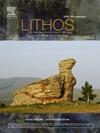A sheared garnet peridotite mantle xenolith from the Delitzsch Carbonatite Complex, Germany - Evidence for thickened Cretaceous lithosphere beneath Central Europe
IF 2.9
2区 地球科学
Q2 GEOCHEMISTRY & GEOPHYSICS
引用次数: 0
Abstract
Sheared garnet peridotites occur in the deep lithosphere and record processes of deformation, melt interaction, and metasomatism along the lithosphere-asthenosphere boundary (LAB). While sheared peridotites are typically found in kimberlites and related volcanic rocks within cratonic settings, this study reports on an exceptionally fresh occurrence found in an ultramafic lamprophyre (UML) from the Delitzsch Carbonatite Complex (DCC) in Saxony, Germany. The xenolith was emplaced during the main magmatic activity, previously dated to between 72 and 83 Ma during the late Cretaceous period. The xenolith contains porphyroclasts of garnet, clinopyroxene and orthopyroxene in a fine-grained matrix of olivine, and thus classifies as garnet-lherzolite. Evidence of deformation and metasomatism is recorded in its mosaic to fluidal mosaic texture, characterized by olivine neoblasts, elongated garnet grains, and reaction rims around garnet (kelyphite) and clinopyroxene (spongy rims). The xenolith represents a relatively fertile mantle composition with magnesium numbers (Mg# = Mg/[Mg + Fe2+] × 100) of 89.4 for olivines and clinopyroxenes, 90.8 for orthopyroxenes and 82.6 for garnets. Measured trace element compositions suggest high temperature interaction with primitive, fertile melts, as shown by an enrichment of middle rare earth elements (MREE) as well as high field strength elements (HFSE) such as Ti. Reconstructed P-T conditions indicate equilibration at 61.1 ± 5.1 kbar and 1330 ± 23 °C. The corresponding depth of ∼190 km is substantially deeper than the depth of the modern LAB at 120-140 km. This not only establishes the sheared garnet peridotite xenolith as the deepest sample ever recorded from Germany but also has significant implications for mantle dynamics beneath the Mesozoic Central European crust. The sheared garnet peridotite provides evidence of the destabilization and destruction (e.g., by delamination) of a formerly thick lithosphere at least beneath Eastern Germany and possibly beneath Central Europe. Such thick, craton-like lithosphere could have originally underlain the Bohemian Massif and extended to the NW at upper mantle depth.
来自德国Delitzsch碳酸盐岩杂岩的剪切石榴石橄榄岩地幔捕虏体——中欧下加厚白垩纪岩石圈的证据
剪切石榴石橄榄岩产于岩石圈深部,记录了岩石圈-软流圈边界(LAB)的变形、熔融相互作用和交代过程。剪切橄榄岩通常在克拉通背景下的金伯利岩和相关火山岩中发现,但本研究报告了在德国萨克森州Delitzsch碳酸盐岩杂岩(DCC)的超镁铁质煌斑岩(UML)中发现的一种异常新鲜的剪切橄榄岩。捕虏体是在主要岩浆活动期间植入的,之前的年代为白垩纪晚期的72 - 83 Ma。捕虏体中含有石榴石、斜辉石和正辉石的斑岩碎屑,呈细粒橄榄石基质,属石榴石-辉橄榄岩。其从镶嵌到流体镶嵌的纹理中记录了变形和交代的证据,其特征是橄榄石新母细胞、细长的石榴石颗粒以及围绕石榴石(榴辉石)和斜辉石(海绵状边缘)的反应边缘。橄榄石和斜辉石的镁含量(Mg# = Mg/[Mg + Fe2+] × 100)为89.4,正辉石为90.8,石榴石为82.6。测量的微量元素组成表明与原始的、肥沃的熔体存在高温相互作用,表现为中稀土元素(MREE)和高场强元素(HFSE)如Ti的富集。重建的P-T条件表明在61.1±5.1 kbar和1330±23°C下达到平衡。相应的~ 190 km深度比现代LAB的120 ~ 140 km深度深得多。这不仅确立了剪切石榴石橄榄岩捕虏体是德国有史以来记录的最深样本,而且对中生代中欧地壳下的地幔动力学具有重要意义。剪切的石榴石橄榄岩提供了不稳定和破坏(例如,通过分层)的证据,以前厚的岩石圈至少在东德,可能在中欧。这种厚的、克拉通状的岩石圈最初可能位于波西米亚地块之下,并在上地幔深度向北西延伸。
本文章由计算机程序翻译,如有差异,请以英文原文为准。
求助全文
约1分钟内获得全文
求助全文
来源期刊

Lithos
地学-地球化学与地球物理
CiteScore
6.80
自引率
11.40%
发文量
286
审稿时长
3.5 months
期刊介绍:
Lithos publishes original research papers on the petrology, geochemistry and petrogenesis of igneous and metamorphic rocks. Papers on mineralogy/mineral physics related to petrology and petrogenetic problems are also welcomed.
 求助内容:
求助内容: 应助结果提醒方式:
应助结果提醒方式:


